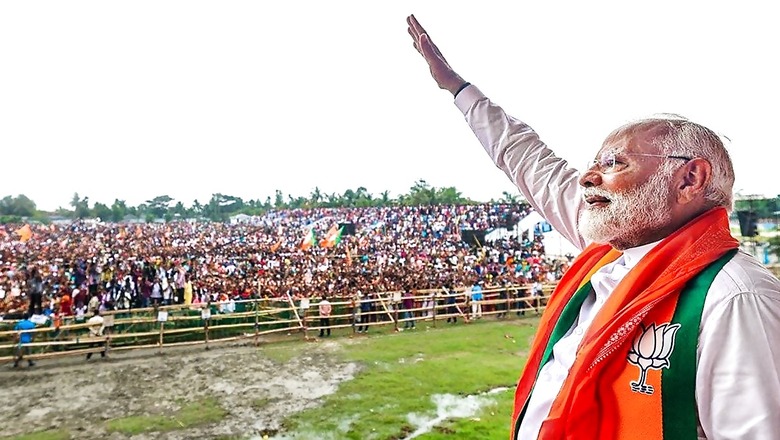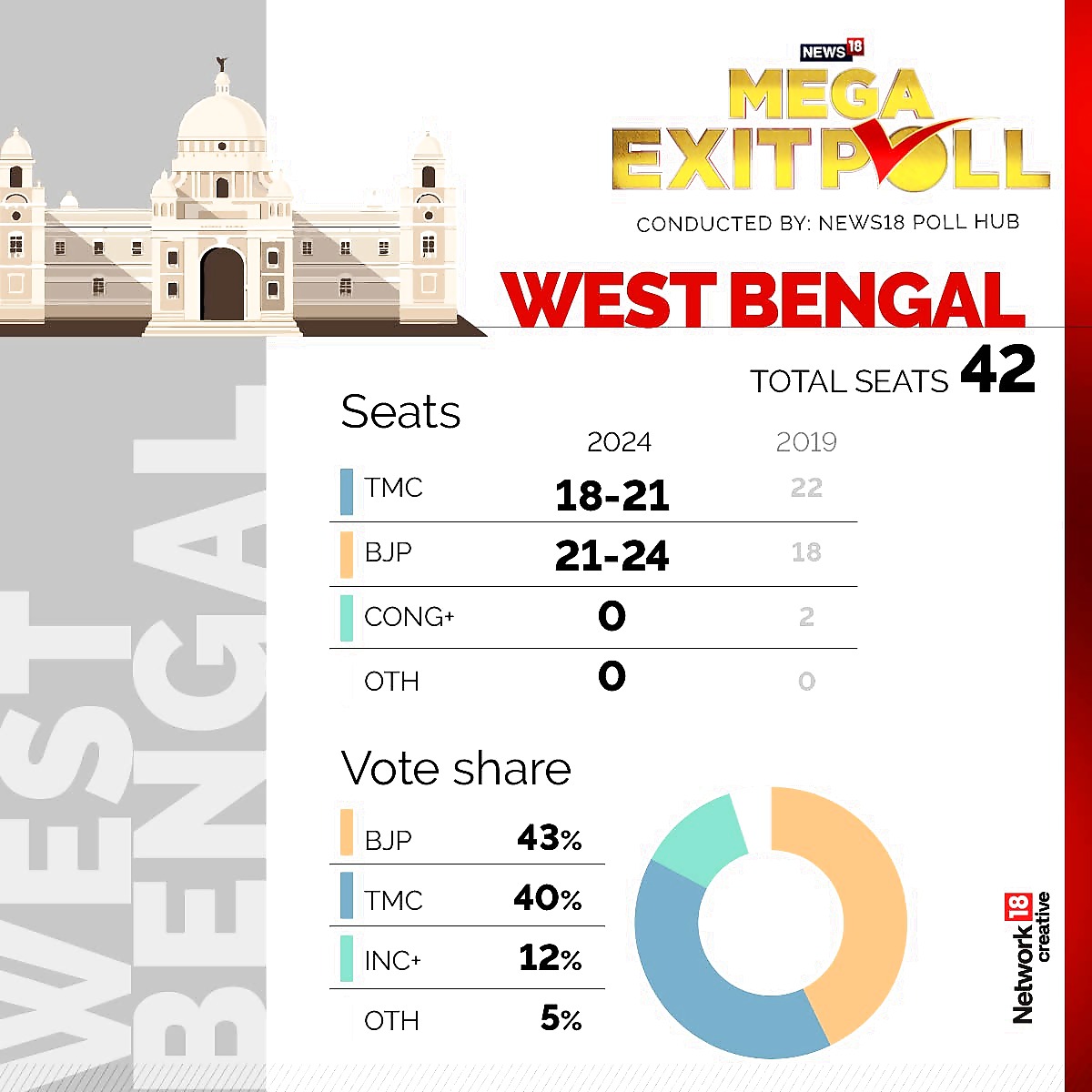
views
The BJP-led NDA is projected to win at least 21, and up to 24, seats of the 42 in West Bengal. This will be a significant leap from the 18 it won last time. The state’s ruling Trinamool Congress, led by chief minister Mamata Banerjee, is likely to shrink to as little as 18 seats from the 22 it won last time. The other two seats had gone to the Congress, but the party — fighting in alliance with the Left this time — is unlikely to open its account.
According to the News18 Mega Exit Poll, the BJP may win 21 to 24 seats in West Bengal, with the TMC predicted to win 18 to 21 seats and none to the Congress-Left alliance.

The BJP’s eye set firmly on increasing their tally than before, West Bengal is one of the crucial states to keep an eye on with a total of 42 seats up for grabs. In 2019, the BJP more than doubled its vote share, while the Left and Congress saw massive erosion in their numbers.
The eastern state, where poll-related violence is common, voted in all seven phases. This time, according to the Election Commission of India, it had the largest deployment of security forces, which will be retained there till June 6.
West Bengal consistently recorded a high voter percentage in the first six phases of the general elections. On Saturday, it recorded 70 per cent in nine Lok Sabha seats till 5 pm, which went to polls in the seventh phase. The final phase, however, was marred with violence with reports of clashes between TMC, ISF and BJP workers in various parts of Jadavpur and Diamond Harbour constituencies.
What are the stakes?
There was a three-pronged battle in most seats between the ruling TMC, opposition BJP and the CPI(M), which is in alliance with the Congress as part of the INDIA bloc. As seen in the 2019 elections, in which the BJP bettered its tally from a mere two seats to 18, there has been a significant political shift from the left to the right. The CPI(M) did not win any seat in the state in the previous polls.
The TMC faces a significant electoral battle testing the party’s dominance, with the national spotlight on Sandeshkhali in Basirhat due to allegations of atrocities on women and land grabs. This time, the chief minister’s party also has to fight off a challenge from the Left-Congress alliance. This could have been a confusing election for voters in the state as the TMC boss endorses the INDIA bloc at a national level, and has said she will give “outside support” to the opposition front if it wins the election this time.
Who are the key candidates?
Several constituencies were pegged to witness high-stakes battles in each phase, especially Kolkata North, Asansol, Barrackpore, Medinipur, Darjeeling, Jadavpur and Basirhat. Key candidates in the fray were TMC heavyweights like Abhishek Banerjee from Diamond Harbour and Mahua Moitra from Krishnanagar, actor Shatrughan Sinha from Asansol and cricketer Yusuf Pathan from Baharampur, who faced Congress veteran Adhir Ranjan Chowdhury; BJP’s Dilip Ghosh from Burdwan-Durgapur, Sukanta Majumdar from Balurghat, Raju Bista from Darjeeling, Locket Chatterjee from Hooghly and Arjun Singh from Barrackpore.
How did the election campaign go?
All the mainstream parties have conducted a series of high-energy road shows with an intense campaign – often bordering on the use of unparliamentary language, verbal duels and cross-trading of charges – ever since the polls were announced in mid-March. There were multiple twists and turns in terms of shifts and changes in strategies and issues.
While Prime Minister Narendra Modi led the BJP juggernaut by addressing 19 public meetings in the state and his first-ever roadshow in Kolkata, the TMC’s counter-offensive was helmed by Mamata, who addressed more than a staggering 150 rallies and quite a few road shows entailing street walks.
While Modi was backed up by home minister Amit Shah and BJP president JP Nadda besides state leaders Suvendu Adhikari and Sukanta Majumdar, Abhishek – the de facto number two – played the perfect second fiddle to the CM in crisscrossing the state and reaching out to voters.
The BJP ended with the prime minister’s grand roadshow in north Kolkata, supporting party candidates Tapas Roy and Silbhadra Dutta. The TMC supremo, meanwhile, responded by holding a counter roadshow on the same route in 24 hours. Her 12-km walk at a stretch across two constituencies – Jadavpur and Kolkata Dakshin – adding the final bit of colour to her three-month electioneering.
During the campaign, the BJP highlighted issues of coal and cattle smuggling, irregularities in recruitment in schools and Sandeshkhali where local TMC leaders were accused of forcible land grabs and sexual atrocities on women.
The TMC, meanwhile, alleged that the BJP-led Centre did not release funds due to the West Bengal government. They claimed that the central government was misusing central probe agencies like the CBI and ED as a political tool to torment leaders of opposition parties.
What will decide the election in Bengal?
The Muslim factor is key in deciding a number of seats in the state and could work in favour of the TMC, but the BJP is banking on its sustained campaign against poll-related violence and the alleged atrocities in Sandeshkhali, where it has nominated a prominent local protestor Rekha Patra against TMC veteran Haji Nurul Islam and CPI(M)’s former MLA Nirapada Sardar.
Prime Minister Narendra Modi’s personal call to Patra before her campaign has added momentum to her candidacy. The saffron party has focused on issues of corruption, women’s safety, and resistance to political muscle-flexing, which they believe resonate strongly.
The TMC, on the other hand, is banking on its developmental work and the charisma of its leaders to retain its dominance. The Left-Congress combine, armed with veteran candidates such as Sujan Chakraborty and first-timers like Srijan Bhattacharya, aims at breaking the TMC-BJP binary and reclaiming its relevance in Bengal politics.
There has been intensified communal polarisation over the OBC reservation controversy while Mamata’s contentious comments regarding monks from renowned religious institutions kept the state on edge till the very end of this mega electoral exercise.
According to political observers, these developments have not only deepened existing divides but also put the TMC at a strategic disadvantage, with the BJP aggressively capitalising on the situation. Last week, the Calcutta High Court struck down the other backward classes (OBC) status of several classes in Bengal granted since 2010, observing that such reservations to vacancies in services and posts in the state are “illegal”.
“Religion indeed appears to have been the sole criterion” for declaring these communities as OBCs, the court said, adding that it “is of the view that the selection of 77 classes of Muslims as backwards is an affront to the Muslim community as a whole”. The ruling, which Mamata said she will challenge before a higher court, has affected nearly five lakh OBC card holders. Alleging that the court order was “influenced” by the BJP’s poll narrative, she said no one can take away the constitutionally protected rights of the OBCs.
On May 18, Mamata sparked another controversy by criticising a section of monks from the Ramakrishna Mission (RKM), Bharat Sevashram Sangha (BSS), and the International Society for Krishna Consciousness (ISKCON), accusing them of political involvement with the BJP. While the developments triggered different reactions across the state’s political spectrum, they also led to both the TMC and the BJP intensifying their efforts to polarise voters.
Political analyst Maidul Islam suggests that the court’s ruling could exacerbate the communal divide, with the BJP effectively leveraging Hindu OBC grievances to bolster their electoral prospects.
“This ruling affects approximately 5 lakh people, leading to significant discontent among various communities. Muslim OBCs, who had shown signs of disillusionment with the TMC, may now realign with Mamata’s party in light of the court’s decision. However, Hindu OBCs, who have increasingly supported the BJP since 2019, are likely to consolidate their backing for the saffron party,” he told PTI.
Muslims are a key demographic constituent in 17 Lok Sabha seats, of which the TMC presently holds 12. The BJP and Congress shared three and two seats, respectively, of the remaining five. West Bengal provides 17 per cent reservation for OBCs, divided into two categories – OBC A with 10 per cent for 81 communities (56 of which are Muslims), and OBC B with 7 per cent for 99 communities (41 of which are Muslims).
Another political analyst Suman Bhattacharya, however, suggested that Banerjee’s remarks were not without a political motive. “A segment of the Bengali ‘bhadralok’ community, or the liberal and elite Bengalis, had been drifting away from the TMC towards the Left and Congress for various reasons. This issue could again sway their support towards the TMC, garnering the backing of a significant portion of the Bengali elite,” he said.
How was the News18 Mega Exit Poll conducted?
The News18 Poll Hub survey covered all 518 seats in 21 major states, which account for 95% of Lok Sabha constituencies in the country. In each Lok Sabha constituency, 180 interviews were conducted using a structured questionnaire, which was translated into 11 regional languages. For phases one to six, the interviews were conducted the ‘day after’, as it is known to yield more reliable responses, and the traditional exit poll – asking people coming out of the polling booth – was carried out for Phase 7.
A total sample size of 93,240 across 21 states was planned, but over 95,000 was achieved. In each Lok Sabha constituency, three Vidhan Sabha constituencies were covered, with 10 polling booths in each selected through random sampling. Around each polling station, trained investigators conducted 15 door-to-door interviews – one eligible respondent with inked finger per household. In case of the exit poll, near each polling station, 15 interviews were conducted of people coming out after casting their votes, with every fifth person stopped for interview.
On-spot checks by senior field manager and executives, geo-tagging of interviews and telephonic back-checks for 20% of the sample in each state were among the many steps taken to maintain quality.
You can catch the live updates of Lok Sabha Elections 2024 Exit Polls here on News18.com. To catch accurate predictions and timely information, keep an eye on our website. Stay tuned for more updates.
Check detailed seat predictions based on Exit Poll Results 2024 LIVE . Get minute-by-minute updates on the exit polls from Andhra Pradesh.

















Comments
0 comment